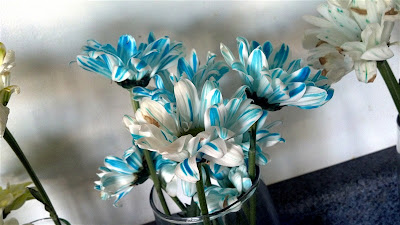We saw some fantastic results too!
 |
| Our colored flowers...Tricia over at Hodgepodge suggested the idea...I'm just a science girl though and this activity screamed chromatography to me.(and I can't help sharing good science when I see it!) |
 |
| The blue was the most brilliant of all. |
 |
| See how the purple split into the blue and the red...a few days later it all looked purple again. |
 |
| We might have to try this again with some different colors...they'd make a nice Easter decor. |
 |
| For the record, I bought these daisies with the necrosis. This wasn't my fault. |
 |
| Good science deserves some data collection... |
This was a fun activity and it yielded some good science! We noticed that the primary colors showed up first and dyed the best of all the flowers. We also observed that the secondary colors split into their primary molecules and traveled at different rates. In the purple flowers, the blue got to the tip of the flower first and it was followed by the red and eventually it turned more purple as the red got closer to the end. The same thing happened in the green flowers- some of the flowers never did turn all green. They looked blue and yellow with the yellow trailing behind the blue.
Now I used to think this was based on the size of the molecule. For instance, the blue molecules are the smallest and they can travel to the end faster. However, Dan pointed out that things are more complicated in a living system like the flower vs something like chromatography paper (or something like a coffee filter). While he was doing graduate work he started working on a project to optimize some diffusion type work that would allow faster DNA readings. As the research group worked with molecules they began to find that the slower molecules appeared slow because they could meander into places along the way the other molecules could not. Then they could continue on and eventually reach the end of the paper, etc.
Our results certainly show this! In the purple flower, the red did some meandering while the blue shot out of the gate and reached the finish line first. However, eventually the red joined up with the blue and the longer we left the flowers, the more evident this became.
Pretty cool stuff and a great way to show kids the behaviors of molecules!
Next up...dying some wool yarn. Easter egg dye style!


5 comments:
Those turned out beautiful! And, great science activity.
Absolutely fabulous results! Your photos and data are wonderful. Love your notebook details/sketches and how you modeled it for the children. Makes me all excited to do it again this year. Thanks for sharing Heather! ~Tricia
Well, the color split could have also been caused by differences in binding affinities between the dye molecules, variations in diffusion rates unrelated to size, etc.. You just can't tell without more data!
You should take one to the doubting Thomas Wegman's lady. :) I did this with white roses and it was pretty! http://hollyhock-hill.blogspot.com/2007/09/science-coloring-roses_25.html
I love this! For sure we'll be trying it out - I never thought of doing the experiment with flowers before! Thanks.
Post a Comment